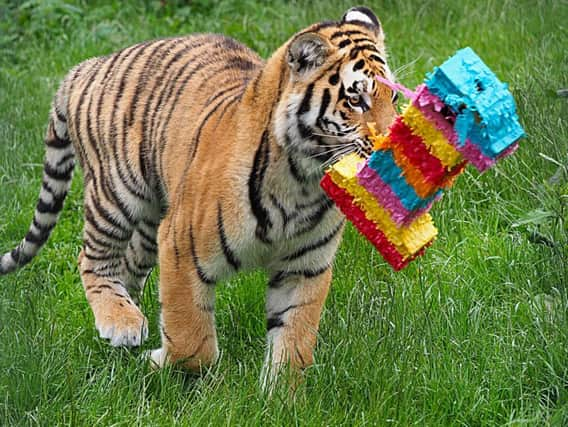Video shows endangered tiger cubs at Whipsnade Zoo celebrating first birthday


Three endangered Amur tiger cubs at ZSL Whipsnade Zoo got a special surprise from their zookeepers on Wednesday as they celebrated their first birthday with multi-coloured party pinatas.
The one-year-old stripy cubs, Dmitri, Makari and Czar, who were born on 23 June 2018 to mum Naya and dad Botzman, were each given a colourful pinata in the shape of a “1”, which instead of sweets, were stuffed with their favourite meaty treats.
Advertisement
Hide AdAdvertisement
Hide AdIt is the first in a week full of birthday surprises for the cubs, which will culminate in them getting huge gift boxes full of their favourite foods on Saturday 22 June at the Zoo’s Sunset Safari event.


Team Leader Donovan Glyn said: “To have three endangered Amur tiger cubs, growing into strong and healthy males, is something to really celebrate, especially when you consider there are only 500 left in the wild.
“A pinata is the perfect party game for a tiger cub, because they love to explore new things and practice their pouncing skills! They wasted no time in tearing off the paper to get to the good stuff!”
The birth of the cubs in 2018 was heralded as a success for the European Endangered Species breeding Programme (EEP) which works with zoos across the continent to breed the endangered species.
Advertisement
Hide AdAdvertisement
Hide AdDonovan Glyn continued: “It’s been a wonderful year watching them grow and develop – not only for us, but for all the visitors who come to see them. There’s been incredible interest in them from day one, so I know many visitors will be excited to see them open their birthday presents at Sunset Safari.”
Amur tigers (Panthera tigris altaica) are classified as Endangered by the IUCN Red List of Endangered Species. Thanks to the conservation efforts of organisations like ZSL (Zoological Society of London), which works with Amur tigers in the Russian Far East, there are now an estimated 500 Amur tigers left in the wild, ten times the number that were estimated to exist in the 1940s.